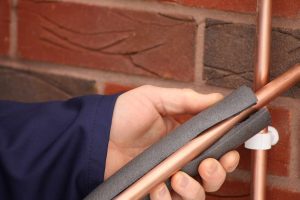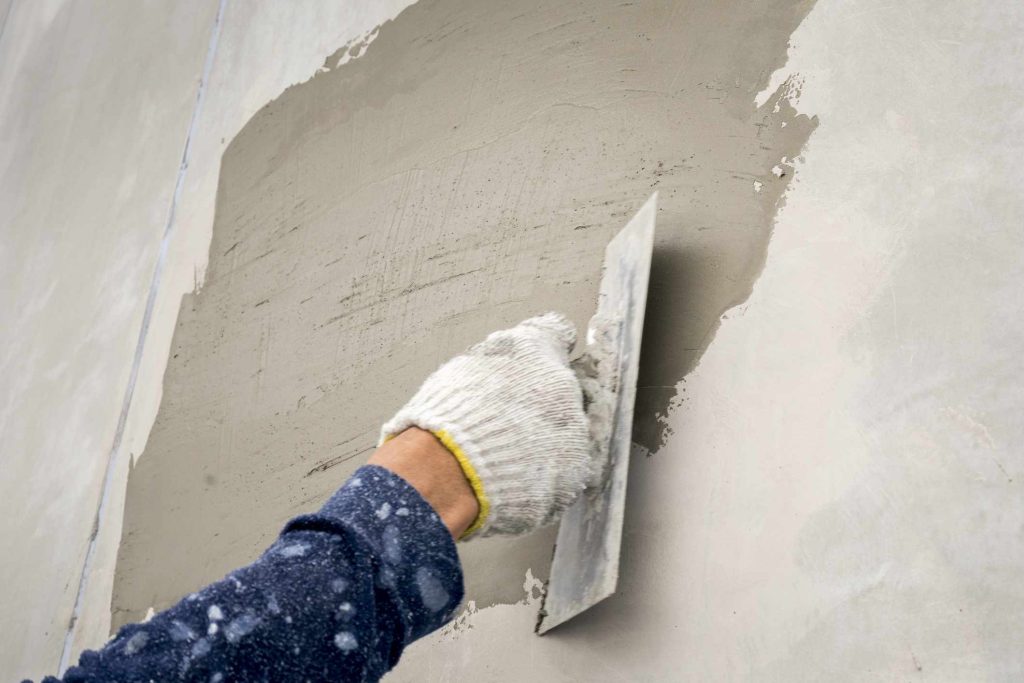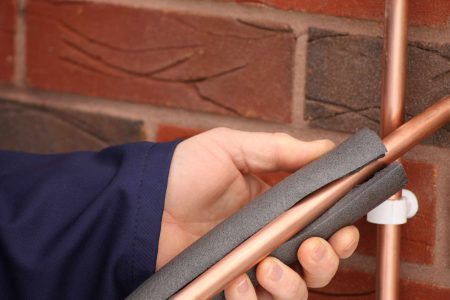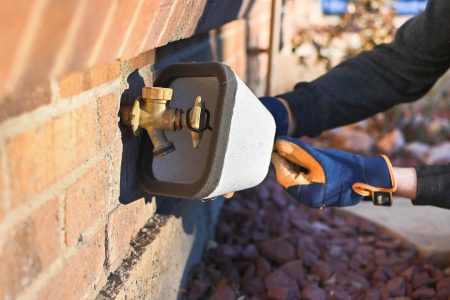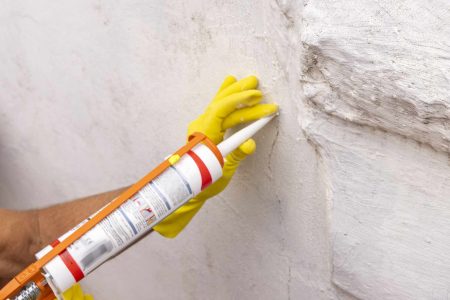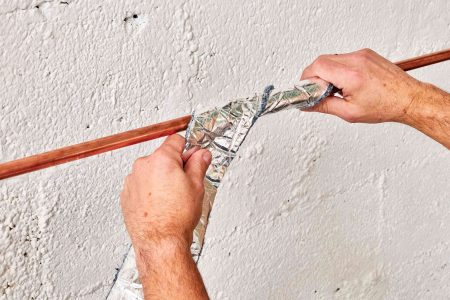Compared to many home improvement and repair projects, resurfacing concrete is a relatively easy task that can be done with concrete resurfacing products available at any home improvement center or hardware store. Resurfacing concrete is a good option when the surface of a wall, structure, or slab is cosmetically marred but in otherwise good shape. Resurfacers will not correct deep cracking or heaving, but they can cover over routine flaking of a concrete surface or small pits due to spalling. If your concrete has significant damage, it may be better to replace it.
Old concrete inside or outside your home can benefit from resurfacing or other coverings for a more attractive appearance. A concrete slab that has been damaged by road salts can be renewed quite easily with a coating of resurfacer. Some homeowners opt to cover interior concrete walls with drywall for a cheaper alternative. Exterior concrete walls, on the other hand, can be resurfaced or covered with faux veneers like stone.
Once you’ve decided to resurface concrete, it’s important to prepare it properly. Apply the resurfacer carefully according to manufacturer instructions, and allow the resurfacer plenty of time to cure, you’ll be rewarded with a garage floor, driveway, sidewalk, or patio that looks as good as new.
Concrete Resurfacing Products
The major manufacturers of concrete products, including Quickrete and Sakrete, all sell concrete resurfacing products. Usually, these consist of a blend of Portland cement, fine sands, polymer modifying compounds, and other additives that make these products easy to apply and spread over existing concrete surfaces. Concrete resurfacers can be spread in thin layers from 1/16 to 1/2 inch thick. These special mixtures are fairly expensive products, but in the right application, they can make a concrete slab look brand new.
Concrete resurfacing products are intended only for covering the surface of concrete and will serve to repair only the most superficial cracks and pits. For more substantial repairs, such as wide cracks or those that have slight vertical shifts, you will need to first repair the areas using a product that is specifically designed for patching, such as Sakrete’s Top ‘n Bond, and then follow up with a complete resurfacing treatment.
Before You Begin
It is critical that the concrete surface is cleaned of all loose debris. A strong spray from a garden hose and long-handled scrub brush may suffice, but a good pressure washing will provide better cleaning.
You should also remove any oil stains, paint, or tree sap from the concrete. If your efforts fail to remove the stain entirely, consider applying a sealer over the stain before resurfacing. If left unsealed, the stain will very likely bleed through the resurfacing layer.
It is important that expansion joints be protected when resurfacer is applied. Mask off these control joints with duct tape or weather stripping to prevent the resurfacer from filling them in.
What You’ll Need
Equipment / Tools
- Garden hose
- Power washer
- 5-gallon plastic bucket
- 1/2-inch drill and mixing paddle
- Long-handled squeegee
- Concrete edger
- Broom
Materials
- 20 Bags of dry concrete resurfacer
Instructions
How to Resurface Concrete
-
Repair the Surface
Concrete resurfacers should be viewed as cosmetic finishes, not repair products. When serious damage is widespread, resurfacing will mask the problems for only a short time. But if you have only minor cracks or pits in your surface, resurfacing can be effective, provided you first repair the damage with a product specifically formulated for patching.
Patch any serious damage with another concrete patching product, and let it dry completely before proceeding to resurfacing.
-
Mix the Resurfacer
For best results, mix and apply one bag of resurfacer at a time. One 40-pound bag will usually require six pints of water. Use warm water in cool temperatures, and cold water in warmer temperatures. At 73 degrees Fahrenheit, you will have about 20 minutes of working time before the resurfacer hardens.
Pour the water into a clean 5-gallon plastic bucket, then empty the resurfacer into the bucket and mix for several minutes into a smooth, pourable consistency. Let the contents rest for a few minutes, and then mix it again. Add a little more water or resurfacer, if necessary, to create a pourable mix that has the consistency of syrup.
-
Apply the Resurfacer
Resurfacer needs to be applied to a moist surface so the concrete won’t draw moisture out of the resurfacer as it cures. Just before mixing and applying the resurfacer, give the slab a cooling spray with the hose and sweep off any standing water from the surface.
The easiest method for applying concrete resurfacer is to pour a small amount on the surface, then immediately begin spreading it evenly with a light, long-handled squeegee. Resurfacer can also be applied with a trowel or brush.
Work in segments of no more than about 144 square feet at a time. If possible, segment your work so that you are working to edges of control and expansion joints with each application.
Where a second coat is necessary, let the surface dry for two to three hours, then apply a second coat following the same procedure. Most manufacturers recommend a second coat, but this is optional; your decision should be based on how well the first coat has covered small imperfections.
-
Scuff the Surface
If the resurfacer is allowed to cure without any finishing touches, it will create a smooth surface. That’s often what you want in a garage. However, the smooth finish can be slippery when wet, which makes it less desirable on a driveway, sidewalk, or patio surface.
To add some texture or “tooth” to the finish, use a long-handled broom to make full strokes across the surface. Plan to do this within five minutes of application, while the mix is still wet enough. Make sure all broom strokes are made in the same direction.
-
Allow the Resurfacer to Cure
As concrete resurfacer cures, it hardens and becomes stronger. Wait about eight hours before walking on resurfaced concrete, and at least two days before driving on it.
Resurfacer should be kept slightly moist while curing. Covering with plastic is only necessary to protect the surface from rain immediately after application, but the surface should be lightly misted with water once or twice a day for the first two days.
-
Does cracked concrete need to be replaced?
Not all cracked concrete needs to be replaced. Small cracks and chips can be repaired using a concrete resurfacing product. If your concrete is beginning to leak or the cracks start to widen over time, it’s best to consult a professional about replacing the concrete.
-
How long does concrete resurfacing last?
Concrete resurfacing products typically last between eight and 20 years, while brand-new concrete can last between 50 and 100 years. Resurfacing is an affordable alternative to replacing concrete as long as it is still structurally sound.
-
Can you put wall panels on concrete walls?
Wall panels can be installed on concrete walls to finish a space and offer a more attractive appearance. Repair any cracks or holes prior to covering the concrete.
Read the full article here


